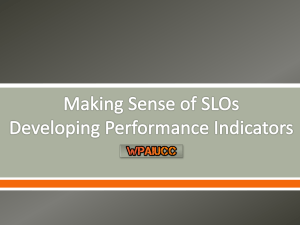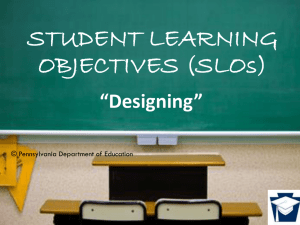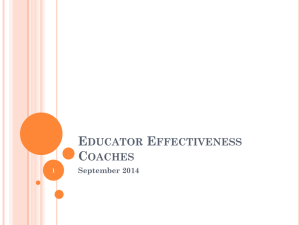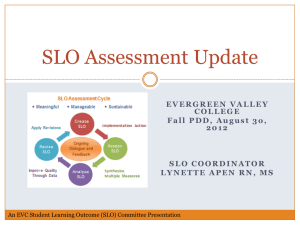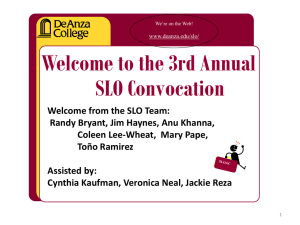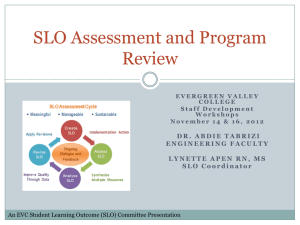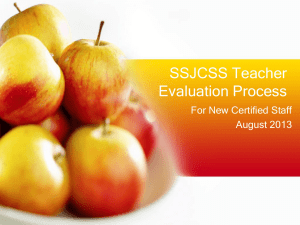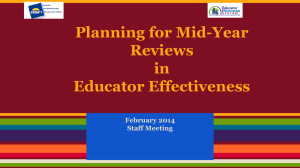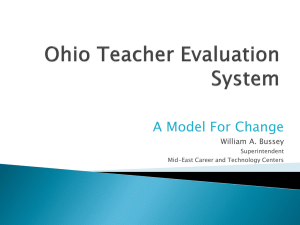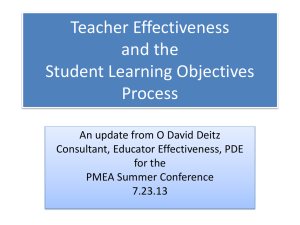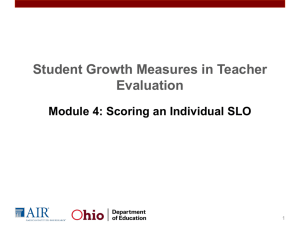PMEA-Conference-Presentation
advertisement
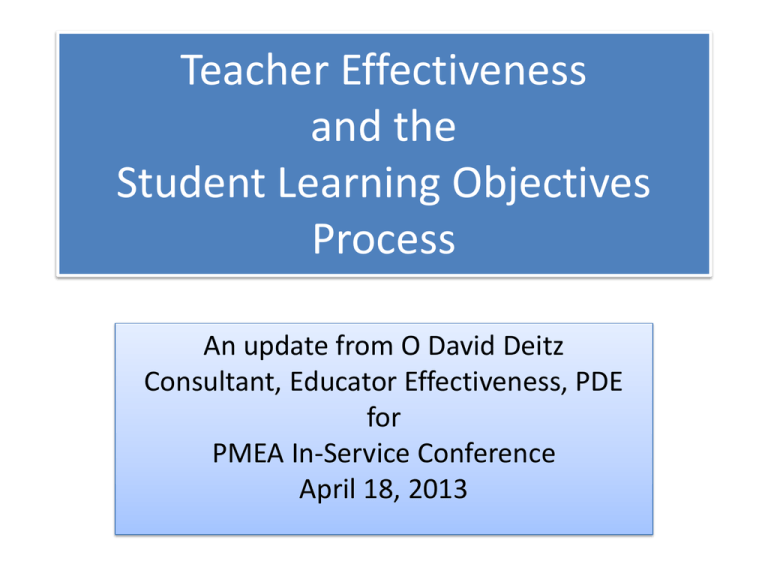
Teacher Effectiveness and the Student Learning Objectives Process An update from O David Deitz Consultant, Educator Effectiveness, PDE for PMEA In-Service Conference April 18, 2013 • • • • • • • • • • • • • • • • (B) FOR PROFESSIONAL EMPLOYES AND TEMPORARY PROFESSIONAL EMPLOYES WHO SERVE AS CLASSROOM TEACHERS, THE FOLLOWING SHALL APPLY: (1) BEGINNING IN THE 2013-201 4 SCHOOL YEAR, THE EVALUATIO N OF THE EFFECTIVENESS OF PROFESSIONAL EMPLOYES AND TEMPORARY PROFESSIONAL EMPLOYES SERVING AS CLASSROOM TEACHERS SHALL GIVE DUE CONSIDERATION TO THE FOLLOWING: (I) CLASSROOM OBSERVATION AND PRACTICE MODELS THAT ARE RELATED TO STUDENT ACHIEVEMENT IN EACH OF THE FOLLOWING AREAS: (A) PLANNING AND PREPARATION. (B) CLASSROOM ENVIRONMENT. (C) INSTRUCTION. (D) PROFESSIONAL RESPONSIBILITIES. (II) STUDENT PERFORMANCE, WHICH SHALL COMPRISE FIFTY PER CENTUM (50%) OF THE OVERALL RATING OF THE PROFESSIONAL EMPLOYE OR TEMPORARY PROFESSIONAL EMPLOYE SERVING AS A CLASSROOM TEACHER AND SHALL BE BASED UPON MULTIPLE MEASURES OF Teacher Effectiveness Observation/Evidence Building Level Data Danielson Framework Domains 1. Planning and Preparation 2. Classroom Environment 3. Instruction 4. Professional Responsibilities Indicators of Academic Achievement Indicators of Closing the Achievement Gap, All Students Indicators of Closing the Achievement Gap, Subgroups Academic Growth PVAAS Other Academic Indicators Credit for Advanced Achievement Effective 2013-2014 Effective 2013-2014 SY Building Level Data, 15% Elective Data/SLOs Observation/ Evidence, 50% Elective Data, 35% Piloting 2013-2014 SY Effective 2014-2015 SY District Designed Measures and Examinations Nationally Recognized Standardized Tests Industry Certification Examinations Student Projects Pursuant to Local Requirements Student Portfolios Pursuant to Local Requirements Observation/Evidence (50%) Charlotte Danielson’s Framework for Teaching 4 Domains, 22 Components Principal/Evaluator Observes Domain Focus— Adapted from Danielson’s Framework for Teaching Planning and Preparation What a teacher knows and does in preparation for teaching. 6 Classroom Environment All aspects of teaching that lead to a culture for learning in the classroom. Professional Responsibilities Instruction Professional responsibilities and behavior in and out of the What a teacher does classroom. to engage students in learning. 6 Domain 1: Planning and Preparation (offstage) 1a Demonstrating Knowledge of Content and Pedagogy 1b Demonstrating Knowledge of Students 1c Setting Instructional Outcomes 1d Demonstrating Knowledge of Resources 1e Designing Coherent Instruction 1f Designing Student Assessments Domain 2: Classroom Environment (onstage) 2a Creating an Environment of Respect and Rapport 2b Establishing a Culture for Learning 2c Managing Classroom Procedures 2d Managing Student Behavior 2e Organizing Physical Space Domain 3: Instruction (onstage) 3a Communicating With Students 3b Using Questioning and Discussion Techniques 3c Engaging Students in Learning 3d Using Assessment in Instruction 3e Demonstrating Flexibility and Responsiveness Domain 4: Professional Responsibilities (offstage) 4a Reflecting on Teaching 4b Maintaining Accurate Records 4c Communicating with Families 4d Participating in a Professional Community 4e Growing and Developing Professionally 4f Showing Professionalism Danielson Framework, Domain 3: Instruction 11 Multiple Measures of Student Achievement 1. Building Level Data (School Performance Profile) Academic Achievement, Graduation/Promotion Rate, Attendance, AP-IB Courses offered, PSAT, Building Level PSSA and Keystone Assessment Data 2. Correlation Data Based on Teacher Level Measures PSSA, Keystone Data 3. Elective Data (SLOs) What is a SLO? (Student Learning Objective) A (5)process to (4) document a (3) measure of educator effectiveness based on (2)student achievement of (1)content standards. 13 SLO Concepts • Student achievement can be measured in ways that reflect authentic learning of content standards. • Educator effectiveness can be measured through use of student achievement measures. SLO Big Idea We can use student achievement on the assessments listed below to measure teacher effectiveness. District Designed Measures and Examinations Nationally Recognized Standardized Tests Industry Certification Examinations Student Projects Pursuant to Local Requirements Student Portfolios Pursuant to Local Requirements How do we do this? SLO Template Refer to the SLO Template handout. Page 1: Classroom Context, SLO Goal, Student Performance Indicator Page 2: Student Performance Measure, Teacher Expectations Page 1. Teacher Information, Setting • 1a-1c: Teacher Information Teacher Name School Name District Name • 1d. Course Title/Targeted Content Area General Statements: Grade General Music, Elementary Band Emphasis Statements: A specific concept, unit, PSSA reported category • 1e: Grade Level 5th Grade; 9,10,11,12 • 1f: Students for whom the SLO is written (and why) Statements: 60 students (3 Sections 3rdth General Music, as opposed to all 6 sections—collecting data for a sample of students as opposed to using all students) Page 1. SLO 2a. The SLO Goal Statement: What is the Important Learning (Content)? HS Choral Ensemble Students will demonstrate independent performance skills appropriate to positive musical contribution in a choral performing ensemble. Kindergarten Classroom Music Students will create, recreate, and express music through the use of their voice, instruments, and movement 8th Grade General Music Students will demonstrate independent production and creation of music and apply concepts as informed consumers of music. HS Music Technology Level 1 Students will demonstrate proficiency in musical arranging/composing through the use of a Digital Audio Workstation (DAW). Page 1. SLO (cont.) 2b. Standards selection •Targeted content standards used in developing the SLO. 2c. Rationale statement •Explains why the SLO is important and how students will demonstrate learning of the standards through this objective. 1. Know and understand the Standards PA Standards National Common Core Arts Standards (new 2013) 2. Assessment Tasks Authentic to the grade or course Aligned to Standards 3. Assessment Scoring Can describe levels of student achievement toward standards based learning Page 1 cont. – Student Performance Expectations 3: Performance Indicator Describes individual student performance expectation a. What performance measure(s) –tests, assessments– will be used to measure student achievement of the standards, and what’s the expected student achievement level based on the scoring system for those measures? b. What’s the expected achievement level for unique populations? (IEP, students who did not do well on a pre-test, etc.) Performance Indicator Statement HS Choral Individual Vocal Assessment Task Students will achieve proficient or advanced levels in 6 out of 8 criteria of the second scoring rubric. Individual Sight Singing Task Students will achieve proficient or advanced levels in 2 out of 3 criteria indicated on the second scoring rubric. Music Technology Students are expected to achieve a proficient level on all performance measures in both Music Based and Technology Based Rubrics. Page 1 cont. – Student Performance Expectations 3: Performance Indicator Describes individual student performance expectation c. Are the performance measures linked? (Must an individual student demonstrate proficiency on all measures to be described as proficient?) b. Should some performances measures count more because they address standards that are addressed more in this course of study? Page 2. Student Performance Measure What’s the Test? 4a: What are the names of the performance measures? 4.b: Who created them? 4c: How do they relate to the learning objective? Are they appropriately rigorous? (Webb’s Depth of Knowledge) 4d. Will the performance measure show growth over time or achievement of the learning standards, or both?? 4e: How often is the test given? 4f: Will certain populations need any accommodations to complete the performance measures? 4g. Are any unique resources (or purchased materials) needed to implement the performance measures? 4h: What are the scoring tools? (test keys, rubrics, checklists, etc.) 4i. What background do personnel need to administer and score the performance measures? 4j. How will student achievement be reported to verify (5a) Teacher Expectations? 5a: Teacher Effectiveness Measure Describes the number of students expected to meet the performance indicator criteria. 5a: Proficient 85% to 94% of students meet the performance indicator. How is PA planning to implement the SLO component? 1. Provide Models 2. Provide Assessment Literacy Dr. J.P Beaudoin Research In Action Student Achievement Measures Development Design and Purpose, Item Specification, Test Blueprint, Scoring Keys, Operational Forms & Administrative Guidelines, Form Review SLO Template Development Design and Development Calibration and Quality Review Developing Assessment Literacy Current Training Modules in Process for PA Use Template The SLO Process Training Orientation Module Vetting and Review Training Module SLO Quality Assurance Review Checklist Refinement Control Checklist-PDE Version SLO Rubric Page 1, Section 2 The Student Learning Objective Training Module 1: Design and Purpose Statement Handout 1: Purpose Statement Handout 2: Targeted Standards Template 1: Purpose Statement Template 2: Targeted Standards Vetting and Review Worksheet 1: SLO Rationale Worksheet 2: Standards Selection Worksheet 3: SLO Blueprint Final Page1, Section 3 Achievement Expectations Training Module 4: Scoring Keys and Rubrics Page 2, Sections 4 Performance Measure Training Module 2: Test Specification and Blueprint Handout 3: Test Specification and Blueprint Designs Handout 4: DoK Cheat Sheet Template 3: Test specifications and Blueprint Module 3: Item Specifications5: Item Examples & Item Tag Coding Handout 4: DoK Cheat Sheet Handout 5: Item Examples & Item Tag Coding Module 4: Scoring Keys and Rubrics Handout 6: Scoring Key Example Handout 7: Rubric Examples Template 5: Scoring Key Rubric Module 5: Operational Forms and Administrative Guidance Handout 8: Operational Form Demo Handout 9: Administrative Guidelines Demo Template 4: Operational Form Example (Algebra 1 Post-test) Template 6: Administrative Guidelines Module 6: Form Reviews Handout 10: Quality Assurance Checklist (Final) Vetting and Review SAM-L Rubric Implementation Process to Date 1. Research from other states and educational resources (RSN, REL, CTAC, Center For Assessment, CTCURRICULUM.ORG, etc.) 2. Develop the SLO process 3. Create models through practitioner development groups Vet, clean and repair the models for presentation Develop online resources to create SLOs Train IU and District level leaders Take a year to let everyone practice the process Questions? (Relax! The process materials will be online!) Educator Effectiveness: SLO SLO Resources http://nassauboces.org/Page/1667 http://www.riseindiana.org/sites/default/files/files/RISE%201.0/Student%20Learning% 20Objectives%20Handbook%201%200%20FINAL.pdf http://www.louisianaschools.net/compass/student_learning_goals.html http://www.ride.ri.gov/EducatorQuality/EducatorEvaluation/SLO.aspx http://www.gadoe.org/School-Improvement/Teacher-and-LeaderEffectiveness/Documents/SLO%20Manual.pdf Assessment Development Resource: beta.ctcurriculum.org O David Deitz Consultant, PDE oddeitz@comcast.net
